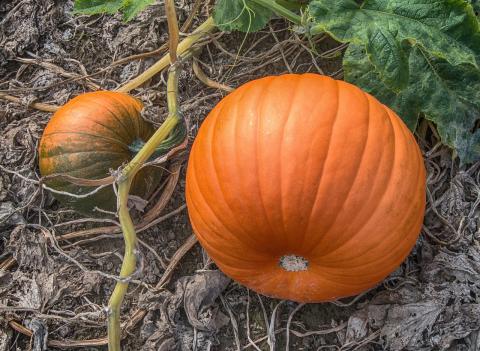How can I successfully grow my own pumpkins for Halloween?

Pumpkins can be quite easy to grow, even for beginner gardeners. They are a warm season crop, which means that they germinate best once the chance of frost is completely gone and the top few inches of soil have reached at least 60°F. In New Hampshire this means planting in late May or early June, depending on which part of the state you live. Most pumpkin varieties require between 90 and 120 days to reach maturity. Although pumpkins can be started indoors, they do not like to have their roots disturbed and can be difficult at times to successfully transplant. Since they are such fast growers, pumpkins can just as easily be directly sown in the garden.
For optimal growth, plant pumpkins in full sun, in garden soils that are well-drained and high in organic matter. Adding compost or well-rotted manure to the pumpkin patch, as well as the recommended amount of lime and fertilizer (based on soil test results) will go a long way toward success. Pumpkins are generally planted on hills, because mounded soil warms faster early in the season and excess moisture is readily allowed to drain away. Of course, hills will also dry out faster than the surrounding soil and may need to be watered more frequently. In most cases pumpkins will grow just as well if they are planted on level ground.
Pay close attention to which kind of pumpkin you plan to plant, as some plants have the potential to get very large and may exceed the size of your garden. Pumpkins come in vining, semi-bush, and bush varieties, the latter of which is more suitable for small spaces or raised beds. For between row spacing, bush varieties require 4-5 feet, semi-bush types need 6-8 feet, and long-vining plants should have 10-12 feet. In row spacing of plants depends to a certain degree on fruit size. Space small fruiting plants 18-24 inches apart, medium 24-36 inches apart, and large varieties 36-72” apart. Sow two to three seeds at the right spacing interval and thin to one plant per space once the seedlings are established. If planted on hills, plant 4-5 seeds per mound and thin to the two strongest seedlings.
Pumpkins have shallow root systems so it is important to weed early and often to avoid too much disturbance and competition with your plants. A good way of keeping weed pressure down and conserve soil moisture is to mulch with weed-free compost, grass clippings, or straw. Pumpkins also appreciate consistent soil moisture, so irrigation may be necessary during periods of drought. Aim to apply one inch of irrigation a week in the absence of adequate rainfall, watering in the morning until the soil is moistened to a depth of 6-8 inches.
Don’t forget to frequently scout the pumpkin patch for pest and disease issues. Powdery mildew, cucumber beetles, squash bugs and squash vine borers are common problems that are easier to manage when they are discovered early. Ask UNH Extension for recommendations on how to handle these or any other issues you may encounter during the growing season.
Got questions? The Ask UNH Extension Infoline offers practical help finding answers for your home, yard, and garden questions. Call toll free at 1-877-398-4769, Monday to Friday, 9 a.m. to 2 p.m., or e-mail us at answers@unh.edu.
Related Resource(s)
Do you love learning about stuff like this?
SUBSCRIBE TO Granite State Gardening newsletter
Got questions? The UNH Extension Yard and Garden Infoline offers practical help finding answers for your yard and garden questions.
Call toll free at 1-877-398-4769, Monday to Friday, 9 a.m. to 2 p.m., or fill out webform.
